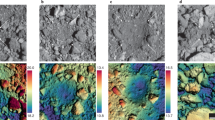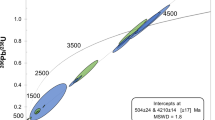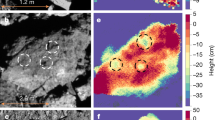Abstract
The surface strength of small rubble-pile asteroids, which are aggregates of unconsolidated material under microgravity, is poorly constrained but critical to understanding surface evolution and geologic history of the asteroid. Here we use images of an impact ejecta deposit and downslope avalanche adjacent to a 70-m-diameter impact crater on the rubble-pile asteroid (101955) Bennu to constrain the asteroid’s surface properties. We infer that the ejecta deposited near the crater must have been mobilized with velocities less than Bennu’s escape velocity (20 cm s–1); such low velocities can be explained only if the effective strength of the local surface is exceedingly low, nominally ≤2 Pa. This value is four orders of magnitude below strength values commonly used for asteroid surfaces, but it is consistent with recent estimates of internal strength of rubble-pile asteroids and with the surface strength of another rubble-pile asteroid, Ryugu. We find a downslope avalanche indicating a surface composed of material readily mobilized by impacts and that has probably been renewed multiple times since Bennu’s initial assembly. Compared with stronger surfaces, very weak surfaces imply (1) more retention of material because of the low ejecta velocities and (2) lower crater-based age estimates—although the heterogeneous structure of rubble piles complicates interpretation.
This is a preview of subscription content, access via your institution
Access options
Access Nature and 54 other Nature Portfolio journals
Get Nature+, our best-value online-access subscription
$29.99 / 30 days
cancel any time
Subscribe to this journal
Receive 12 print issues and online access
$259.00 per year
only $21.58 per issue
Buy this article
- Purchase on Springer Link
- Instant access to full article PDF
Prices may be subject to local taxes which are calculated during checkout



Similar content being viewed by others
Data availability
OCAMS data are available via the Planetary Data System (PDS) at https://sbn.psi.edu/pds/resource/orex/ocams.html41. The global image mosaic of Bennu is available in ref. 13. OLA data underlying the DTMs used for slope calculations are available via the PDS at https://sbn.psi.edu/pds/resource/orex/ola.html42. The v.42 global DTM is available from the Small Body Mapping Tool (SBMT) at https://sbmt.jhuapl.edu. The output of the ejecta simulations is archived at https://lib.jhuapl.edu/.
Code availability
The ejecta-simulation programmes are available at https://lib.jhuapl.edu/.
References
Walsh, K. J. Rubble pile asteroids. Annu. Rev. Astron. Astrophys. 56, 593–624 (2018).
Holsapple, K. A. The scaling of impact processes in planetary sciences. Annu. Rev. Earth Planet. Sci. 21, 333–373 (1993).
Melosh, H. J. Impact Cratering: A Geologic Process (Oxford Monographs on Geology and Geophysics Series no. 11, Clarendon Press, 1989).
Scheeres, D. J. Disaggregation of small, cohesive rubble pile asteroids due to YORP. Icarus 304, 183–191 (2018).
Sugita, S. et al. The geomorphology, color, and thermal properties of Ryugu: implications for parent-body processes. Science https://doi.org/10.1126/science.aaw0422 (2019).
Lauretta, D. S. et al. The unexpected surface of asteroid (101955) Bennu. Nature 568, 55–60 (2019).
Lauretta, D. S. in Sample Return Missions (ed. Longobardo, A.) 163–194 (Elsevier, 2021).
Rozitis, B. et al. Asteroid (101955) Bennu’s weak boulders and thermally anomalous equator. Sci. Adv. 6, eabc3699 (2020).
Ballouz, R. L. et al. Bennu’s near-Earth lifetime of 1.75 million years inferred from craters on its boulders. Nature https://doi.org/10.1038/s41586-020-2846-z (2020).
Arakawa, M. et al. An artificial impact on the asteroid 162173 Ryugu formed a crater in the gravity-dominated regime. Science https://doi.org/10.1126/science.aaz1701 (2020).
Rizk, B. et al. OCAMS: the OSIRIS-REx camera suite. Space Sci. Rev. 214, 26 (2018).
Golish, D. R. et al. Ground and in-flight calibration of the OSIRIS-REx camera suite. Space Sci. Rev. 216, 12 (2020).
Bennett, C. A. et al. A high-resolution global basemap of (101955) Bennu. Icarus https://doi.org/10.1016/j.icarus.2020.113690 (2021).
DellaGiustina, D. N. et al. Variations in color and reflectance on the surface of asteroid (101955) Bennu. Science https://doi.org/10.1126/science.abc3660 (2020).
Barnouin, O. S. et al. Digital terrain mapping by the OSIRIS-REx mission. Planet. Space Sci. 180, 104764 (2020).
Daly, R. T. et al. The morphometry of impact craters on Bennu. Geophys. Res. Lett. 47, e2020GL089672 (2020).
Daly, M. G. et al. Hemispherical differences in the shape and topography of asteroid (101955) Bennu. Sci. Adv. 6, eabd3649 (2020).
Jawin, E. R. et al. Global patterns of recent mass movement on asteroid (101955) Bennu. J. Geophys. Res. Planets 125, e2020JE006475 (2020).
Takizawa, S. & Katsuragi, H. Scaling laws for the oblique impact cratering on an inclined granular surface. Icarus 335, 113409 (2020).
Walsh, K. J. et al. Craters, boulders and regolith of (101955) Bennu indicative of an old and dynamic surface. Nat. Geosci. 12, 242–246 (2019).
Scheeres, D. J. et al. The dynamic geophysical environment of (101955) Bennu based on OSIRIS-REx measurements. Nat. Astron. 3, 352–361 (2019).
Chesley, S. R. et al. Trajectory estimation for particles observed in the vicinity of (101955) Bennu. J. Geophys. Res. Planets 125, e2019JE006363 (2020).
Housen, K. R., Schmidt, R. M. & Holsapple, K. A. Crater ejecta scaling laws: fundamental forms based on dimensional analysis. J. Geophys. Res. 88, 2485–2499 (1983).
Housen, K. R. & Holsapple, K. A. Ejecta from impact craters. Icarus 211, 856–875 (2011).
Bierhaus, E. B. et al. Crater population on asteroid (101955) Bennu indicates impact armouring and a young surface. Nat. Geosci. https://doi.org/10.1038/s41561-022-00914-5 (2022).
Slyuta, E. N. Physical and mechanical properties of the lunar soil (a review). Sol. Syst. Res. 48, 330–353 (2014).
Barnouin, O. S. et al. Shape of (101955) Bennu indicative of a rubble pile with internal stiffness. Nat. Geosci. 12, 247–252 (2019).
Honda, R. et al. Resurfacing processes on asteroid (162173) Ryugu caused by an artificial impact of Hayabusa2’s Small Carry-on Impactor. Icarus 366, 114530 (2021).
McCaffrey, W. D. (ed.) Particulate Gravity Currents Vol. 31 (Blackwell Science, 2001).
Iverson, R. M. The physics of debris flows. Rev. Geophys. 35, 245–296 (1997).
Lauretta, D. S. & the OSIRIS-REx TAG team. The OSIRIS-REx touch-and-go sample acquisition event and implications for the nature of the returned sample. In Proc. 52nd Lunar and Planetary Science Conference LPI contribution no. 2548, abstract no. 2097 (2021).
Vokrouhlický, D., Bottke, W. F., Chesley, S. R., Scheeres, D. J. & Statler, T. S. in Asteroids IV (eds Michel, P. et al.) 509–531 (Univ. Arizona Press, 2015).
Bottke, W. F. et al. Interpreting the cratering histories of Bennu, Ryugu, and other spacecraft-explored asteroids. Astron. J 160, 14 (2020).
Roberts, J. H. et al. Rotational states and shapes of Ryugu and Bennu: implications for interior structure and strength. Planet. Space Sci. 204, 105268 (2021).
Bottke, W. F. et al. In search of the source of asteroid (101955) Bennu: applications of the stochastic YORP model. Icarus 247, 191–217 (2015).
Walsh, K. J., Delbo, M., Bottke, W. F., Vokrouhlicky, D. & Lauretta, D. S. Introducing the Eulalia and new Polana asteroid families: re-assessing primitive asteroid families in the inner Main Belt. Icarus 225, 283–297 (2013).
Daly, M. G. et al. The OSIRIS-REx Laser Altimeter (OLA) investigation and instrument. Space Sci. Rev. 212, 899–924 (2017).
Schultz, P. H., Ernst, C. M. & Anderson, J. L. B. Expectations for crater size and photometric evolution from the deep impact collision. Space Sci. Rev. 117, 207–239 (2005).
Housen, K. R., Sweet, W. J. & Holsapple, K. A. Impacts into porous asteroids. Icarus 300, 72–96 (2018).
Golish, D. R. et al. A high-resolution normal albedo map of asteroid (101955) Bennu. Icarus 355, 114133 (2020).
Rizk, B., Drouet d’Aubigny, C., Golish, D., DellaGiustina, D. N. & Laurentta, D. S. Origins, Spectral Interpretation, Resource Identification, Security, Regolith Explorer (OSIRIS‐REx): OSIRIS‐REx Camera Suite (OCAMS) Bundle (NASA Planetary Data System, 2019).
Daly, M., Barnouin, O., Espiritu, R. & Lauretta, D. Origins, Spectral Interpretation, Resource Identification, Security, Regolith Explorer (OSIRIS-REx): OSIRIS-REx Laser Altimeter Bundle (NASA Planetary Data System, 2019).
Acknowledgements
This material is based on work supported by NASA under contracts NNM10AA11C and NNG12FD66C, issued through the New Frontiers Program. The OSIRIS-REx Laser Altimeter and the Canadian authors were supported by the Canadian Space Agency. P.M. acknowledges funding support from the French space agency CNES, from the European Union’s Horizon 2020 research and innovation programme under grant agreement no. 870377 (project NEO-MAPP) and from Academies of Excellence: Complex systems and Space, environment, risk, and resilience, part of the IDEX JEDI of the Université Côte d’Azur. This work used the Small Body Mapping Tool (http://sbmt.jhuapl.edu). We are grateful to C. Wolner for her indispensable editing support and to the entire OSIRIS-REx Team of engineers, operators, scientists and administrators for making the encounter with Bennu possible.
Author information
Authors and Affiliations
Contributions
M.E.P. led the data analysis and writing. O.S.B. led the Altimetry Working Group that produced the DTMs. O.S.B., R.T.D. and C.M.E. contributed analyses and expertise on crater processes. M.G.D. and J.A.S. provided the altimetry data for the high-resolution DTMs. E.B.B. and R.-L.B. provided analyses on crater-retention age. K.J.W., M.C.N. and P.M. contributed to writing. D.N.D. and D.R.G. provided image and spectral analyses. J.P.E., M.M.A., E.R.J., W.F.B. and C.L.J. provided analytical insight. D.S.L. is principal investigator of the OSIRIS-REx mission.
Corresponding author
Ethics declarations
Competing interests
The authors declare no competing interests.
Peer review
Peer review information
Nature Geoscience thanks Akbar Whizin, Jennifer Anderson and the other, anonymous, reviewer(s) for their contribution to the peer review of this work. Primary Handling Editors: Tamara Goldin and James Super, in collaboration with the Nature Geoscience team.
Additional information
Publisher’s note Springer Nature remains neutral with regard to jurisdictional claims in published maps and institutional affiliations.
Extended data
Extended Data Fig. 1 Color-phase slope of Bennu’s surface.
The colors are the phase slope (Golish et al. 2021) from the linear (in magnitude space) phase function, averaged over 1 degree and normalized to the Bennu average. The underlying data are the PolyCam albedo basemap (Golish et al. 2021). Notionally, low phase slope values (blue) indicate a smoother surface. The blue area north of Bralgah Crater is centered at −45°, 325° E. The scale is –10%/+5%, so the flow region is approximately a 10% effect in the phase slope.
Extended Data Fig. 2 Laser altimetry topography of the flow field around boulder 2.
Laser altimetry topography of the flow field around boulder 2 showing elevations 4 to 5 m lower behind (north) of the bolder. The blue and red lines shown in a correspond to the profiles in b.
Extended Data Fig. 3 Topography of Bralgah Crater from laser altimetry data.
Topography of Bralgah Crater from laser altimetry data (Figs. 1, 2)16. a, DTM overlaid onto an OCAMS image (ocams20190419t204556s223_map_iofl2pan_92585). North (downslope) is to the left. b, Eight profiles of the crater. The value d/Delevation is crater depth (calculated from elevation) divided by crater diameter. The apparent asymmetry is due to the prevailing ~23° slope of the local region. Because of compaction and uplift near the crater rim, the total volume of material excavated from an impact crater is typically about 2/3 of the crater volume24,37.
Extended Data Fig. 4 Ejecta mass and velocity as a function of target strength.
Calculations of ejecta velocities and the resulting ejected mass using the equations in Table 1 and published parameters24 for three different low-strength material analogs for Bennu’s regolith. WCB is weakly cemented basalt, and ‘Base’ has the constant C3 = 1 in the strength equation for ejection velocity. a, Fraction of ejecta landing within one crater radius of Bralgah as a function of target strength for the three different types of low-strength materials. The red line represents the fraction for gravity-regime scaling. The highest strengths that produce as much low-velocity ejecta as in the gravity regime are 0.1, 1.2, and 1.9 Pa (marked with circles). We consider this the range of possible strengths for Bennu’s regolith. b, The minimum ejection velocity for the different strength parameterizations. The red line represents the lowest observed speed based on ejecta as close as 1 crater radius from the rim. The solid lines use the Table-1 equations, and the dashed lines include an additional factor that assumes ejecta velocities are not truncated and must smoothly approach zero. Although many of the potential surface properties do not have sufficiently slow velocities at 20 Pa, all of the strength parameterizations have high velocities at 100 Pa.
Supplementary information
Supplementary Information
Additional discussion material.
Rights and permissions
About this article
Cite this article
Perry, M.E., Barnouin, O.S., Daly, R.T. et al. Low surface strength of the asteroid Bennu inferred from impact ejecta deposit. Nat. Geosci. 15, 447–452 (2022). https://doi.org/10.1038/s41561-022-00937-y
Received:
Accepted:
Published:
Issue Date:
DOI: https://doi.org/10.1038/s41561-022-00937-y
This article is cited by
-
Constraining surface properties of asteroid (162173) Ryugu from numerical simulations of Hayabusa2 mission impact experiment
Nature Communications (2022)
-
Inferring interiors and structural history of top-shaped asteroids from external properties of asteroid (101955) Bennu
Nature Communications (2022)
-
A weak and active surface of Bennu
Nature Geoscience (2022)
-
Crater population on asteroid (101955) Bennu indicates impact armouring and a young surface
Nature Geoscience (2022)



